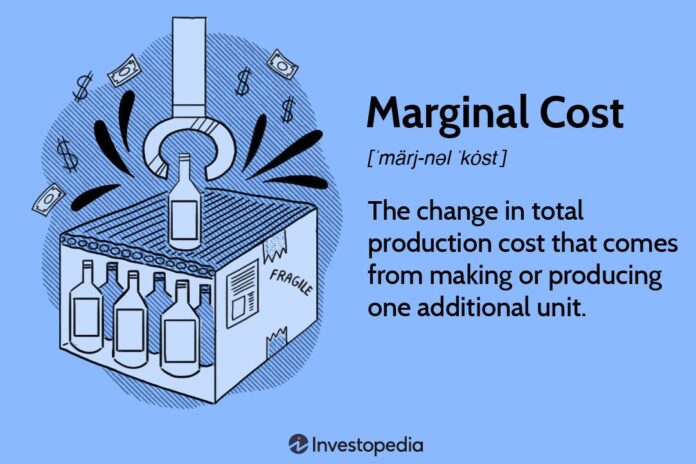The cost increase or decrease incurred by producing or serving an additional unit or client is known as the marginal cost. Another name for it is the incremental cost. It is calculated when production reaches break-even and there are enough units produced to cover fixed costs. From that point on, only direct or variable costs will be incurred. Understanding marginal cost enables you to increase prices and boost your store’s profitability. Discover the fundamentals of marginal cost and calculate your own to build a more successful company. So let us dig in and find out what marginal cost is.
Describing Marginal cost:
When you produce one more unit or make one more unit, then the total production cost changes. Here, marginal cost refers to the change in total production cost after producing that extra unit. It is computed by dividing the variation in quantity by the variation in production costs.
Marginal cost can be used to calculate the optimal production volume and price. Both fixed and variable costs are included. Additionally, investors use it to predict a company’s profit growth as its sales increase. Finding the marginal cost helps businesses make informed decisions about production within their organizations. It helps them understand and calculate how producing an extra unit affects the total cost of production and their business.
Marginal cost formula:
ΔC/ΔQ is the formula to find the marginal cost of production, where Δ stands for change. In simpler words, the formula is Marginal Cost = Change in Total Expenses / Change in Quantity of Units Produced. It can also be written as, MC = ΔTC/ΔQ, where: MC stands for marginal cost, ΔTC stands for the change in the total cost and ΔQ stands for the change in total quantity.
The marginal cost of the nth unit of production may also be computed using the following formula when the quantity is increased by one unit: MCn= TCn – TCn-1, where TC stands for total cost and MC for marginal cost. It is crucial to understand that average cost and marginal cost are different. The average cost means the average cost of producing 1 output whereas the marginal cost finds the cost behind producing the additional unit of output The average cost formula is TC/TQ, where TC is the total cost of production and TQ is the total quantity, and the marginal cost formula is ΔC/ΔQ.
Marginal Cost Curve:
A U-shaped curve represents the marginal cost curve. It shows that the marginal cost is initially relatively large when production begins since it represents the overall cost, which includes both fixed and variable costs. The cost of manufacturing is expensive in the beginning since it involves purchasing machinery, building a plant, and other costs. Because of this, the starting value of the marginal cost curve (MC curve) is higher.
Then there is a drop since more units are produced at the same fixed cost, which keeps the cost of manufacturing low. It begins to climb once more to indicate an increase in the cost of production after it hits the minimum level or point. It is a result of overuse or resource exhaustion.
Difference between Marginal benefit and Marginal cost:
Two crucial metrics for assessing how a product’s worth or price has changed are marginal benefit and marginal cost. We’ve already spoken about what marginal cost means. Let’s now examine what a marginal benefit is. What customers are prepared to pay for an additional unit or item is referred to as the marginal benefit. While the marginal benefit is a measure from the perspective of the consumer, the marginal cost is a factor or measurement from the producer’s perspective. marginal benefit tends to decrease with the increase in consumption. It happens because customer satisfaction tends to decrease when the consumption of the same commodity increases.
Marginal revenue and Marginal cost:
Together, marginal income and marginal cost can help you maximize production. The ideal and perfect production level happens when MC=MR. It means when marginal cost is equal to marginal revenue. But these are not the same two concepts. We have already discussed and mentioned the marginal cost too many times. The difference here is that marginal revenue is the extra money that you or your business earns when it sells one more unit.
The state of the market affects the marginal revenue. In the event of ideal competition, it can be a horizontal line, or it can slope downward due to declining returns. Try to achieve a situation where your marginal revenue is more than the marginal cost, it will be beneficial. Try to reach this level or this situation.
The difference between Average cost and Marginal cost:
The costs incurred in producing one additional good are known as the marginal cost. Over time, the marginal cost often decreases as manufacturing processes become more efficient or as economies of scale are realized. But there’s usually a tipping point where producing one more unit starts to cost a little bit more.
Conversely, average cost is calculated by dividing total production costs by the total units produced. Since marginal cost is frequently inconsistent from one unit to the next, the average cost may differ from the marginal cost. While average cost frequently represents all units produced, marginal cost only represents one unit.
You can find opportunities to cut expenses and boost productivity by having a solid understanding of marginal cost. This simple understanding of marginal cost allows us to not only increase the profit but to expand the business as well. This enhances the knowledge as well. This economic concept t is crucial to company management since it allows companies to maximize their output levels. Concepts like these are also taught in schools, offices, and colleges to expand the horizon of knowledge.
